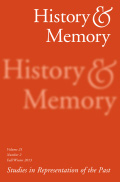Style Guidelines

The final version of the article should include an abstract (around 100 words) followed by a few keywords, to be placed at the beginning of the article, after the title and the author’s name. A brief bio (affiliation, status, recent books/current research) should be placed at the end of the article, after the endnotes.
American spelling and punctuation (but not serial commas) should be used throughout (e.g. characterize, color, traveling; double quotation marks; commas and periods placed inside the quotation marks), but quotations should retain the original spelling.
Numbers: Spell out numbers 1–100; two million, four hundred, 563; 10 percent.
Dates should follow the style: December 10, 1999; twentieth century.
Documentation: History & Memory does not use the bibliographic style of referencing. All bibliographical information, explanations of terms or anecdotal information should be placed in endnotes at the end of the text, in accordance with The Chicago Manual of Style, 16th ed. (humanities). Place endnote numbers at the end of the sentence, after the period. Endnotes should be kept to a minimum and be as brief as possible. References should include the following information:
- Book: Full name of author(s) or editor(s), Title: Subtitle (Place [first city mentioned only]: Publisher, date of publication), pages [without p./pp.] [do not use f./ff.].
- Chapter in edited volume: Full name of author(s), “Title: Subtitle,” in Full names of editors, eds., Book title: Subtitle (Place: Publisher, date of publication), pages.
- Journal article: Full name of author(s), “Title: Subtitle,” Journal vol. no., issue no. (year): pages.
- Newspaper/Magazine article: Full name of author, “Title: Subtitle,” Newspaper/Magazine, date, page [no need for URLs if there is a print edition].
- Dissertation: Full name of author, “Title of Dissertation” (PhD diss., university, year), pages.
- Use a short title for subsequent references; use “ibid.” for reference to the same title as in the previous note (unless it contains more than 1 reference). Do not use “idem” or “op. cit.”
Titles of works in languages other than English should be given in the original (in transliteration for languages not using the Latin alphabet), followed by the translation in brackets (French, Italian, Spanish and German need not be translated).
Electronic sources should be used sparingly as websites tend to be unstable (except for those of large organizations). Give most recent date of access only if the reference itself contains no precise date.
Examples:
1. Maurice Halbwachs, The Collective Memory, trans. Francis J. Ditter, Jr. and Vida Yazdi Ditter (New York: Harper & Row, 1980), 43–47, 110–12.
2. Saul Friedländer, “Trauma, Memory and Transference,” in Geoffrey Hartman, ed., Holocaust Remembrance: The Shapes of Memory (Oxford: Blackwell, 1994), 56.
3. Sharon Macdonald, “Museums, National, Postnational and Transcultural Identities,” Museum and Society 1, no. 1 (2003): 1–16.
4. Michael Bernhard and Jan Kubik, eds., Twenty Years after Communism: The Politics of Memory and Commemoration (New York: Oxford University Press, 2014).
5. Macdonald, “Museums,” 14.
6. Ibid., 10–12.
7. Daniel Majic, “Über den Gräbern der Geschichte,” Berliner Zeitung, April 25, 2014, 1.
8. Mikhail Belov, Pobediteli i pobezhdennye [The victors and the defeated] (Moscow: Voennoe izdatel’stvo, 1996).
9. Ivan Jablonka, L’Histoire est une littérature contemporaine (Paris: Les Éditions du Seuil, 2014).
10. Michael Bernhard and Jan Kubik, “Introduction,” in Bernhard and Kubik, eds., Twenty Years after Communism, 1–2.

